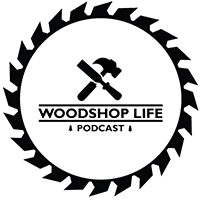Support us on Patreon: https://www.patreon.com/woodshoplife
Guys Questions:
1) A follow-up question that may get Guy going:
I’m currently upgrading my 3hp sawstop pcs 52 inch because I’m moving states and gifting it to my father.
Originally, my thoughts were to go right to the 5HP Sawstop ICS without much consideration for other saws. I do like the safety feature just as an insurance Policy because you never know – we all do stupid things from time to time. Can you speak on times where the sawstop does not operate as intended and fails to save the injury and other saws that may be better but do not include the technology? I am typically pretty careful.
-Ray
2) I emailed a little while ago to ask about MFT tops and all I have found premade so far are MDF tops for the MFT. BUT I found these tops and benches by Armor tools. https://armor-tool.com/products/woodworking/workstations/benches/
It is a butcher block top and has 3/4 inch holes. I do use Festool sanders, a router, and track saw but is there any reason that using a 3/4 inch dog hole top would be inferior to the 20mm top Festool uses? I know the Festool dog hole devices will not work but there are lots of 3/4 inch accessories. If the dog holes are aligned correctly I can bump the Festool track against the dogs to line up cuts. Am I missing a downside?
The armor tool top is $200-250 but seems more sturdy than the MDF.
Lamar
Sean’s Questions:
1) Hey guys. Love the podcast as always. Please keep it up! I have a quick question about finishing. I know you covered this topic but I’m curious about protection from water marks.
I had a client recently that wanted a long desk for her children out of walnut. I explained that water in wood or wood finish is never a good idea. (Leaving standing water, cups rings, etc) is there a finish out there( besides epoxy) that will withstand this water. I am also wondering about hot items. I’ve noticed some finishes(lacquer) will leave a ring if you put a hot cup on it. Are there finishes that won’t fail with either of these issues? Thanks so much.
Ryan Wilging
2) Hey guys,
Love the show, definitely one of the best Woodworking podcasts out there.
I’m going to build a 2 car garage (approx. 24’x30’) for use as my new shop. I’m a hobbyist woodworker, mostly a couple of hours here and there nights and weekends. If you were building a new shop from the ground up, what features and considerations would you recommend?
Thanks, Ron
Huys Questions:
1) My question is regarding Baileigh Industrial tools. I currently own an 8″ Baileigh jointer (IJ-875) and really like it. I’ve been contemplating purchasing a free standing router table and possibly a cyclone style dust collector. My current shop is outfitted nicely with good tools i.e. Powermatic planer, drum sander and mortiser, Sawstop TS, Laguna bandsaw, etc but I’m wondering if any of you have experience with Baileigh and what your opinion is of them. I find their prices are slightly less than say Powermatic and other top brands so it makes sense to consider them only if they’re a trusted brand. I don’t see or hear much about them and all I have to go on is the jointer I have. I will say their manuals leave a lot to be desired. Thanks for any input! Michael
2) Huy, how is the baby? My wife and I had our first not long after you, he is a 4-month-old little boy now – The work life/home life balance came relatively easy, but I’m having trouble adding in shop time especially during the week – if I only have between 5 and 9 with the family how do I justify spending a quarter of that time fooling around in the shop? Or am I now destined to be a weekend warrior? Oh, actual question, how is Huy handling it? Matterhorn woodworks
Our Social Picks:
Sean: @CTFineFurniture
Guy: @prusawoodworks
Huy: Kevin0611
